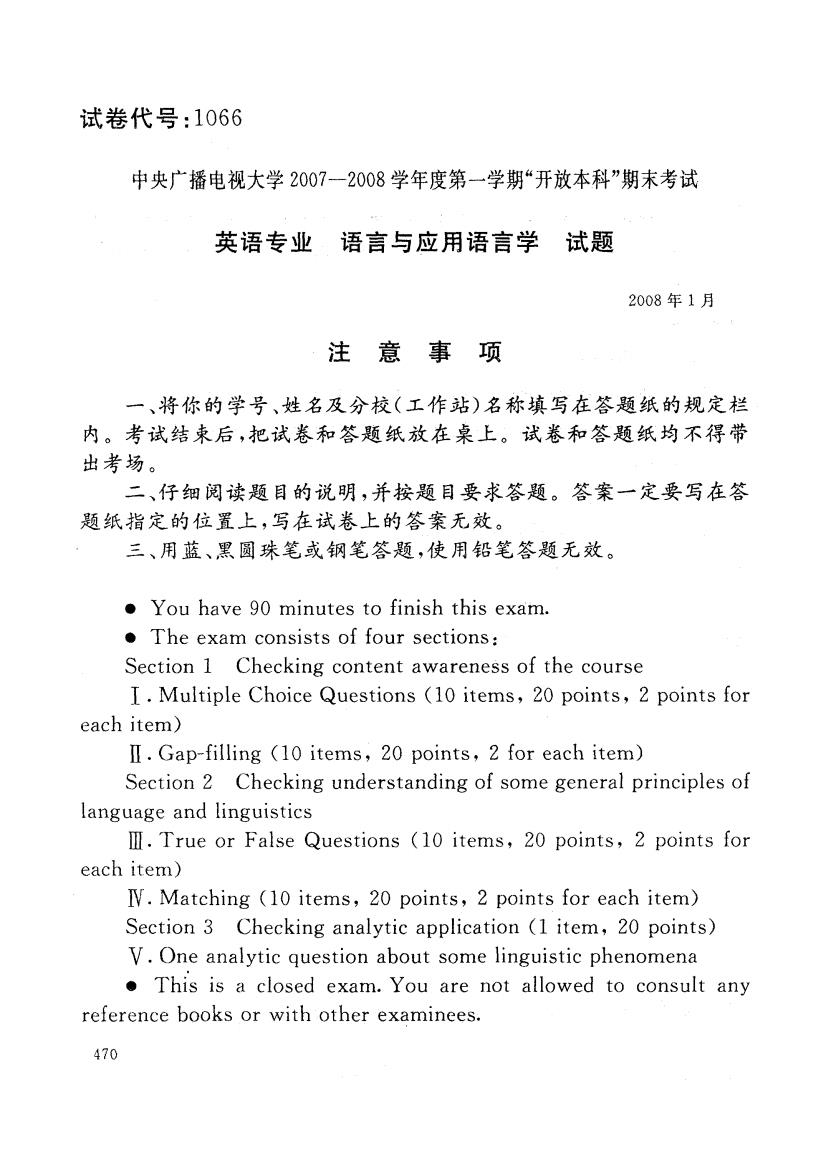
试卷代号:1066 中央广播电视大学2007一2008学年度第一学期“开放本科”期末考试 英语专业语言与应用语言学试题 2008年1月 注意事项 一、将你的学号、姓名及分校(工作站)名称填写在答题纸的规定栏 内。考试结束后,把试卷和答题纸放在桌上。试卷和答题纸均不得带 出考场。 二、仔细阅读题目的说明,并按题目要求答题。答案一定要写在答 题纸指定的位置上,写在试卷上的答案无效。 三、用蓝、黑圆珠笔或钢笔答题,使用铅笔答题无效。 You have 90 minutes to finish this exam. .The exam consists of four sections: Section 1 Checking content awareness of the course I.Multiple Choice Questions (10 items,20 points,2 points for each item) II.Gap-filling (10 items,20 points,2 for each item) Section 2 Checking understanding of some general principles of language and linguistics I.True or False Questions (10 items,20 points,2 points for each item) IV.Matching (10 items,20 points,2 points for each item) Section 3 Checking analytic application (1 item,20 points) V.One analytic question about some linguistic phenomena This is a closed exam.You are not allowed to consult any reference books or with other examinees. 470
试卷代号 :1066 中央广播电视大学2007-2008学年度第一学期“开放本科”期末考试 英语专业 语言与应用语言学 试题 2008年 1月 注 意 事 项 一、将你的学号、姓名及分校(工作站)名称填写在答题纸的规定栏 内。考试结束后,把试卷和答题纸放在桌上。试卷和答题纸均不得带 出考场。 二、仔细阅读题 目的说明,并按题目要求答题。答案一定要写在答 题纸指定的位置上,写在试卷上的答案无效。 三、用蓝、黑圆珠笔或钢笔答题,使用铅笔答题无效。 . You have 90 minutes to finish this exam. . The exam consists of four sections: Section 1 Checking content awareness of the course I.Multiple Choice Questions(10 items,20 points,2 points for each item) fl.Gap-filling(10 items,20 points,2 for each item) Section 2 Checking understanding of some general principles of language and linguistics 1.True or False Questions(10 items,20 points,2 paints for each item) I}.Matching(10 items,20 points,2 points for each item) Section 3 Checking analytic application(1 item,20 points) V.One analytic question about some linguistic phenomena . This is a closed exam. You are not allowed to consult any reference books or with other examinees. 470
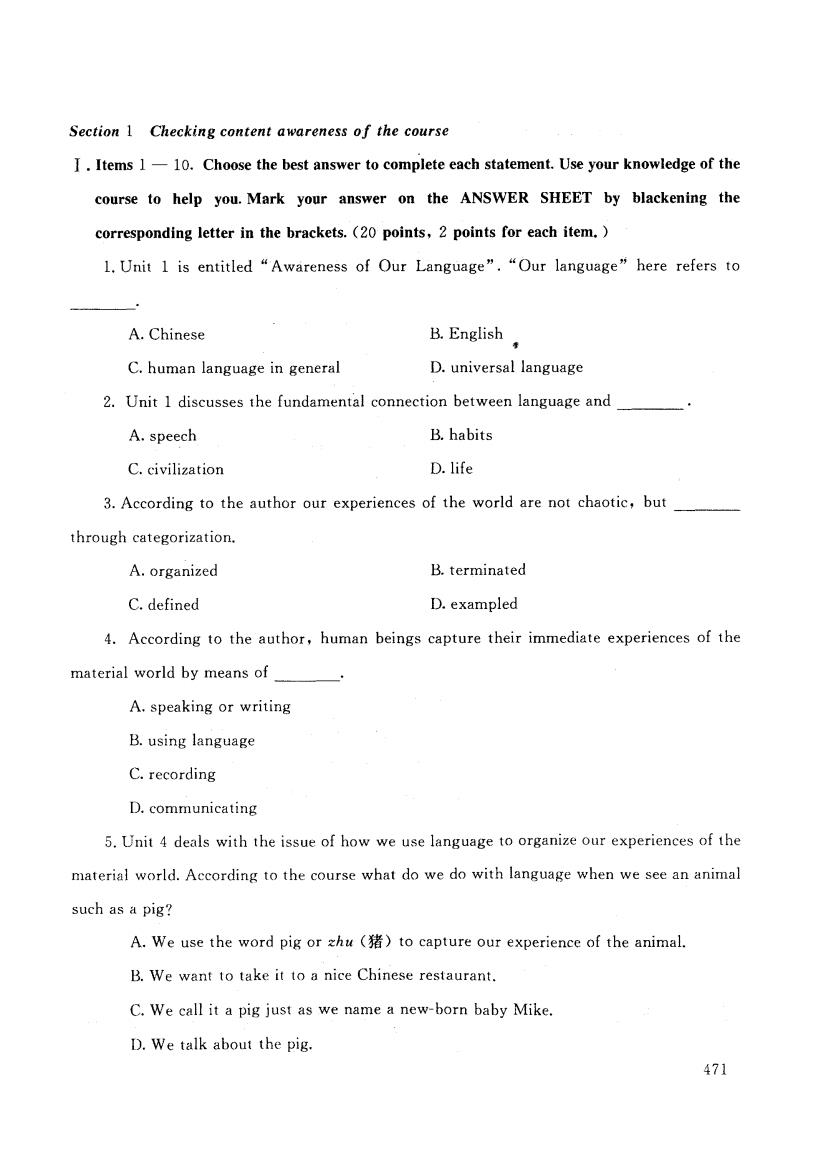
Section 1 Checking content awareness of the course I.Items 1-10.Choose the best answer to complete each statement.Use your knowledge of the course to help you.Mark your answer on the ANSWER SHEET by blackening the corresponding letter in the brackets.(20 points,2 points for each item. L,Unit 1 is entitled“Awareness of Our Language”,“Our language”here refers to A.Chinese B.English C.human language in general D.universal language 2.Unit 1 discusses the fundamental connection between language and A.speech B.habits C.civilization D.life 3.According to the author our experiences of the world are not chaotic,but through categorization. A.organized B.terminated C.defined D.exampled 4.According to the author,human beings capture their immediate experiences of the material world by means of A.speaking or writing B.using language C.recording D.communicating 5.Unit 4 deals with the issue of how we use language to organize our experiences of the material world.According to the course what do we do with language when we see an animal such as a pig? A.We use the word pig or zhu (to capture our experience of the animal. B.We want to take it to a nice Chinese restaurant. C.We call it a pig just as we name a new-born baby Mike. D.We talk about the pig. 471
Section 1 Checking content awareness of the course I.Items 1一 10. Choose the best answer to complete each statement. Use your knowledge of the course to help you. Mark your answer on the ANSWER SHEET by blackening the corresponding letter in the brackets. (20' points, 2 points for each item.) 1. Unit 1 is entitled“Awareness of Our Language".“Our language" here refers to A. Chinese I3. English C. human language in general D. universal language 2. Unit 1 discusses the fundamental connection between language and_ · A. speech B. habits C. civilization D. life 3. According to the author our experiences of the world are not chaotic, but_ through categorization. A. organized B. terminated C. defined D. exampled 4. According to the author,human beings capture their immediate experiences of the material world by means of A. speaking or writing B. using language C. recording D. communicating 5. Unit 4 deals with the issue of how we use language to organize our experiences of the material world. According to the course what do we do with language when we see an animal such as a pig? A. W e use the word pig or zhu(猪)to capture our experience of the animal. 13. We want to take it to a nice Chinese restaurant. C. We call it a pig just as we name a new-born baby Mike. [).We talk about the pig. 471

6.The theme of Unit 3 is the nature of language in which the author describes one of the most fundamental aspects of linguistics. A.organic B.symbolic C.physical D.phonetic 7.There are two most common ways of representing language: A.examinations and signs B.English and Chinese C.signs and gestures D.speech and writing 8.In producing the sound/k/the part of the tongue is used. A.tip B.front C.blade D.back 9.The feature that distinguishes human language from animal language is the of human language. A.innateness B.vocalization C.symbolic aspect D.functionalism 10.A functional analysis of language studies A.what sort of things language helps us to do B.how language helps to define national identities C.how we organize our experience through language D.how we manage interpersonal relationships through language II.Items 11-20.Choose those words or phrases that best complete the following sentences.Mark your answer on the ANSWER SHEET.Note that there are more words or phrases than necessary.(Box A is for items 11-15,and Box B for items 16-20.)(20 points,2 points for each item. Box A Box B A.sign language G.liu脸 B.Braille H.mianzi面子 C.aphasia I.hedges D.the innateness of language J.metaphors E.nature-nurture controversy K.syntagmatic relations F.symbols L.paradigmatic relations M.concepts 472
6. Thetheme of Unit 3 is the_ nature of language in which the author describes one of the most fundamental aspects of linguistics. A.-organic B. symbolic C. physical D. phonetic 7. There are two most common ways of representing language;_ . A. examinations and signs B. English and Chinese C. signs and gestures D. speech and writing 8. In producing the sound's/k/ the part of the tongue is used. A. tip B. front C. blade D. back 9. The feature that distinguishes human language from animal language is the_ of human language. A. innateness I3. vocalization C. symbolic aspect D. functionalism 10. A functional analysis of language studies_ . A, what sort of things language helps us to do 13, how language helps to define national identities C. how we organize our experience through language D. how we manage interpersonal relationships through language fl.Items 11 一 20. Choose those words or phrases that best complete the following sentences. Mark your answer on the ANSWER SHEET. Note that there are more words or phrases than necessary. (Box A is for items 11一 15,and Box B for items 16一 20.)(20 points, 2 points for each item,) Box A Box B A. sign language B. Braille C. aphasia D. the innateness of language E. nature-nurture controversy F. symbols G. liar,脸 H. rnianzi面子 l. hedges J. metaphors K. syntagmatic relations L. paradigmatic relations M. concepts 472
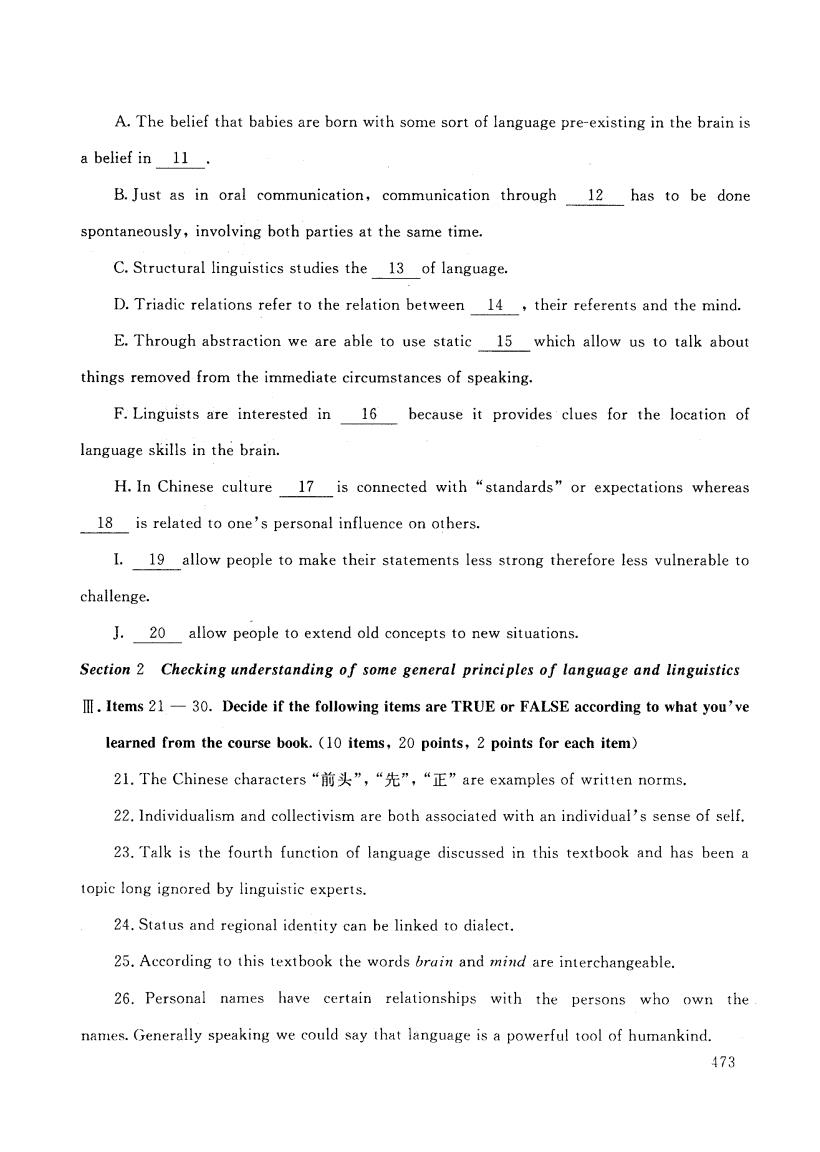
A.The belief that babies are born with some sort of language pre-existing in the brain is a belief in 11. B.Just as in oral communication,communication through 12 has to be done spontaneously,involving both parties at the same time. C.Structural linguistics studies the 13 of language. D.Triadic relations refer to the relation between 14,their referents and the mind. E.Through abstraction we are able to use static 15 which allow us to talk about things removed from the immediate circumstances of speaking. F.Linguists are interested in 16 because it provides clues for the location of language skills in the brain. H.In Chinese culture 17 is connected with "standards"or expectations whereas 18 is related to one's personal influence on others. I.19 allow people to make their statements less strong therefore less vulnerable to challenge. J.20 allow people to extend old concepts to new situations. Section 2 Checking understanding of some general principles of language and linguistics III.Items 21-30.Decide if the following items are TRUE or FALSE according to what you've learned from the course book.(10 items,20 points,2 points for each item) 2i.The Chinese characters“前头”,“先”,“正”are examples of written norms.. 22.Individualism and collectivism are both associated with an individual's sense of self. 23.Talk is the fourth function of language discussed in this textbook and has been a topic long ignored by linguistic experts. 24.Status and regional identity can be linked to dialect. 25.According to this textbook the words brain and mind are interchangeable. 26.Personal names have certain relationships with the persons who own the names.Generally speaking we could say that language is a powerful tool of humankind. 473
A. The belief that babies are born with some sort of language pre-existing in the brain is a belief in 11 B. Just as in oral communication,communication through 12 has to be done spontaneously, involving both parties at the same time. C. Structural linguistics studies the 13 of language. U. Triadic relations refer tothe ar e relation between E. Through abstraction we able to use static their referents and the mind. which allow us to talk about 一 1 口 J改 ‘ 一 1 1 things removed from the immediate circumstances of speaking. F. Linguists are interested in 16 because it provides clues for the location of language skills in the brain. H. In Chinese culture 17 is connected with“standards" or expectations whereas 18 is related to one’s personal influence on others. I. 19 allow people to make their statements less strong therefore less vulnerable to challenge. J 20 allow people to extend old concepts to new situations. Section 2 Checking understanding of some general principles of language and linguistics m.Items 21一 30. Decide if the following items are TRUE or FALSE according to what you've learned from the course book.(10 items, 20 points, 2 points for each item) 21. "the Chinese characters“前头” 22. Individualism and collectivism “先”,“正”are examples of written norms. are both associated with an individual’s sense of self. 23. Talk is the fourth function of language discussed in this textbook and has been a topic long ignored by linguistic experts. Status and regional identity can he linked to dialect. According to this textbook the words bruit and ynirttl are interchangeable. . ‘ 月任 ︼0 夕 臼 9 口 26. Personal names have certain relationships with the persons who own the names. Generally speaking、V e could say that languageIS a powerful tool of humankind. 173
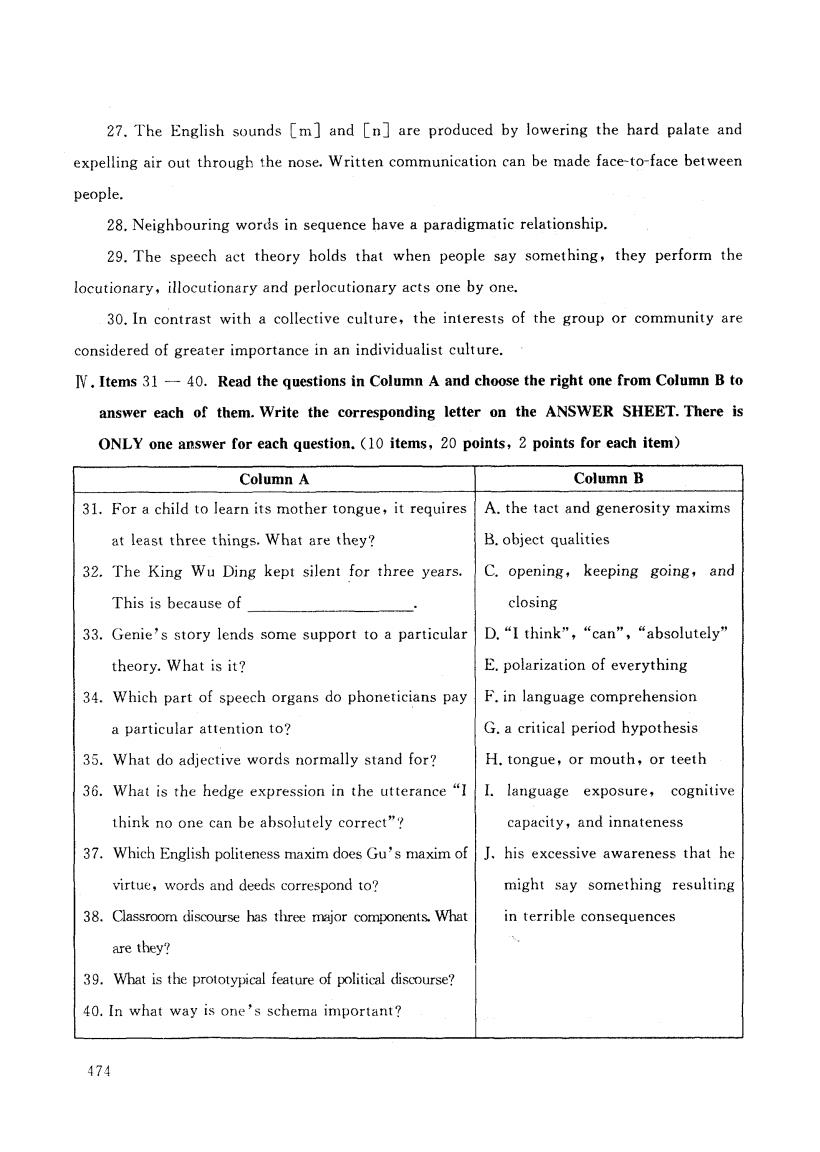
27.The English sounds [m]and [n]are produced by lowering the hard palate and expelling air out through the nose.Written communication can be made face-to-face between people. 28.Neighbouring words in sequence have a paradigmatic relationship. 29.The speech act theory holds that when people say something,they perform the locutionary,illocutionary and perlocutionary acts one by one. 30.In contrast with a collective culture,the interests of the group or community are considered of greater importance in an individualist culture. IV.Items 31-40.Read the questions in Column A and choose the right one from Column B to answer each of them.Write the corresponding letter on the ANSWER SHEET.There is ONLY one answer for each question.(10 items,20 points,2 points for each item) Column A Column B 31.For a child to learn its mother tongue,it requires A.the tact and generosity maxims at least three things.What are they? B.object qualities 32.The King Wu Ding kept silent for three years. C.opening,keeping going,and This is because of closing 33.Genie's story lends some support to a particular D.“I think",“can”,“absolutely'” theory.What is it? E.polarization of everything 34.Which part of speech organs do phoneticians pay F.in language comprehension a particular attention to? G.a critical period hypothesis 35.What do adjective words normally stand for? H.tongue,or mouth,or teeth 36.What is the hedge expression in the utterance"I I.language exposure,cognitive think no one can be absolutely correct"? capacity,and innateness 37.Which English politeness maxim does Gu's maxim of J.his excessive awareness that he virtue,words and deeds correspond to? might say something resulting 38.Classroom discourse has three major components.What in terrible consequences are they? 39.What is the prototypical feature of political discourse? 40.In what way is one's schema important? 474
27, The English sounds [m] and [n]are produced by lowering the hard palate and expelling air out through the nose. Written communication can be made face-to-face between people. e e o ‘h T ‘L .fL a l 28. Neighbouring words in sequence have a paradigmatic relationship, 29. The speech act theory holds that when people say something, they perform Iocutionary, illocutionary and perlocutionary acts one by one. 30.In contrast with a collective culture, the interests of the group or community considered of greater importance in an individualist culture. W.Items 31一 40. Read the questions in Column A and choose the right one from Column answer each of them. Write the corresponding letter on the ANSWER SHEET. There is ONLY one answer for each question.(10 items, 20 points, 2 points for each item) Column A Column B 31. For a child to learn its mother tongue, it requires at least three things. What are they? 32. The King Wu Ding kept silent for three years. This is because of 33. Genie's story lends some support to a particular theory. What is it? 34. Which part of speech organs do phoneticians pay aparticular attention to? 35. What do adjective words normally stand for? 36. What is the hedge expression in the utterance "I think no one can be absolutely correct"`} 37. Which English politeness maxim does Gu's maxim of virtue, words and deeds correspond toy 38. Classroom discourse has three major components. What are they? 39. What is the prototypical feature of political discourse? 40. In what way is one’s schema important? A, the tact and generosity maxims I3, object qualities C, opening, keeping going, and closing D, "I think",+can ,"absolutely" E. polarization of everything F, in language comprehension G, a critical period hypothesis H, tongue,or mouth,or teeth h language exposure, cognitive capacity, and innateness J, his excessive awareness that he might say something resulting in terrible consequences 474
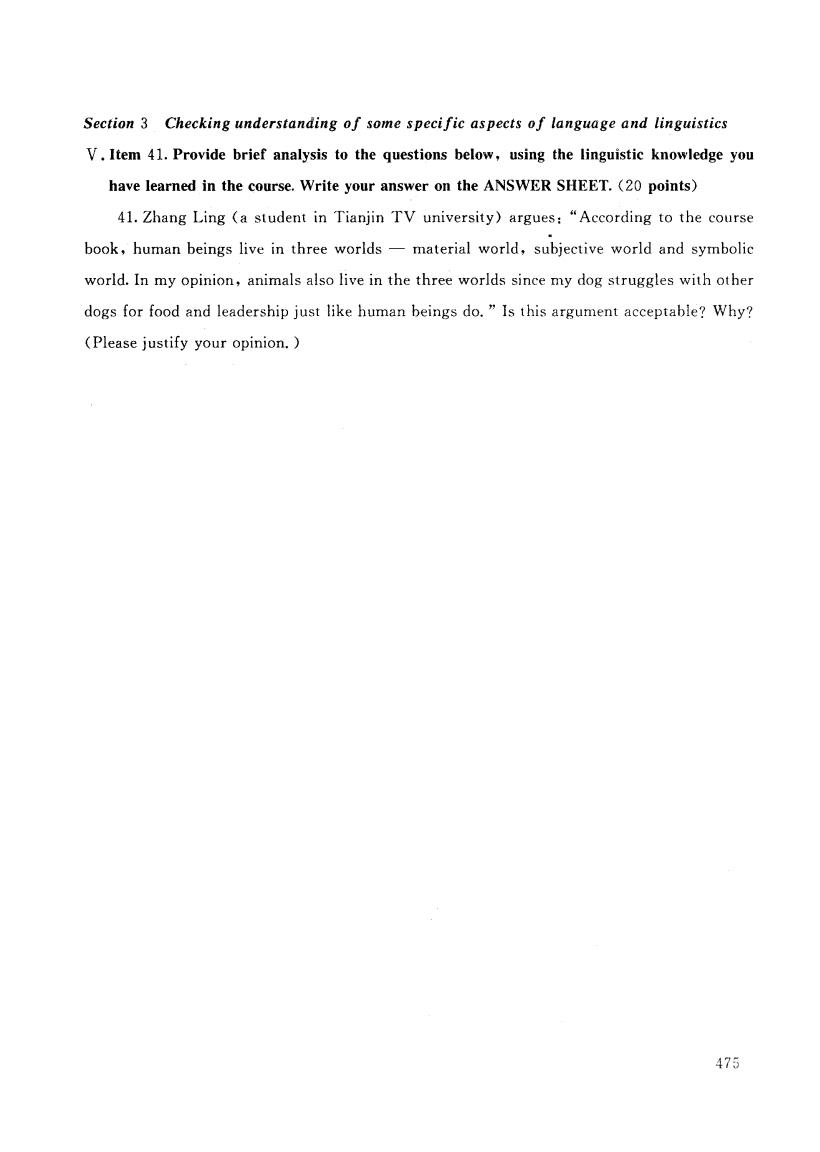
Section 3 Checking understanding of some specific aspects of language and linguistics V.Item 41.Provide brief analysis to the questions below,using the linguistic knowledge you have learned in the course.Write your answer on the ANSWER SHEET.(20 points) 41.Zhang Ling (a student in Tianjin TV university)argues:"According to the course book,human beings live in three worlds-material world,subjective world and symbolic world.In my opinion,animals also live in the three worlds since my dog struggles with other dogs for food and leadership just like human beings do."Is this argument acceptable?Why? (Please justify your opinion. 475
Section 3 Checking understanding of some specific aspects of language and linguistics V.Item 41. Provide brief analysis to the questions below, using the linguistic knowledge you have learned in the course. Write your answer on the ANSWER SHEET. (20 points) 41.Zhang Ling (a student in Tianjin TV university) argues:"According to the course book, human beings live in three worlds一 material world, subjective world and symbolic world. In my opinion, animals also live in the three worlds since my dog struggles with other dogs for food and leadership just like human beings do.”Is this argument acceptable? Why? (Please justify your opinion.) 47石

试卷代号:1066 座位号■ 中央广播电视大学2007一2008学年度第一学期“开放本科”期末考试 英语专业 语言与应用语言学 试题答题纸 2008年1月 题 号 I Ⅱ Ⅲ N V 总 分 分 数 得分 评卷人 I.(10 items,20 points,2 points for each item) 1. 2. 3. 4. 5. 6 7. 8. 9. 10. 得 分 评卷人 II.(10 items,20 points,2 points for each item) 11. 12. 13. 14. 15. 16. 17. 18. 19. 20. 得 分 评卷人 III.(10 items,20 points,2 points for each item) 21. 22. 23. 24. 25. 26. 27. 28. 29. 30. 476
试卷代号:1066 座位号口口 中央广播电视大学2007-2008学年度第一学期“开放本科”期末考试 英语专业 语言与应用语言学 试题答题纸 Zoos年 1月 题 号 I II 皿 N V 总 分 分 数 得 分 评卷人 I.(10 items, 20 points, 2 points for each item) 10 得 分 评卷人 II.(10 items,20 points, 2 points for each item) 11 12 13 14 15 16 17 18 19 20 得 分 评卷人 III.(10 items,20 points, 2 points for each item j 21 22, 23 24 25 26 27 28 29 30 476

得分 评卷人 IV.(10 items,20 points,2 points for each item) 31. 32. 33. 34. 35. 36. 37. 38. 39. 40. 得 分 评卷人 V.(item,20 points) 41. 477
得 分 评卷人 W.《10 items, 20 points, 2 points for each item) 31 32 33 34 35 36 37 38 39 40 得 分 评卷人 V.(item, 20 points) 41 X77
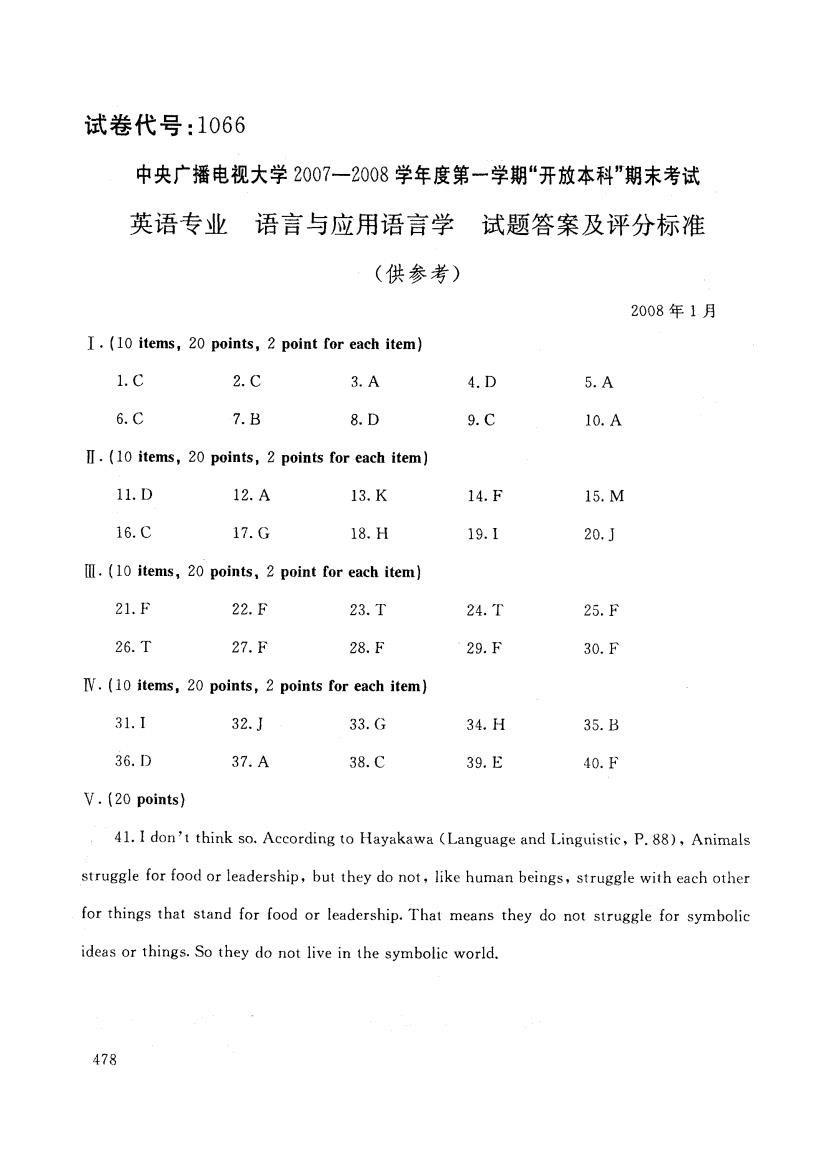
试卷代号:1066 中央广播电视大学2007一2008学年度第一学期“开放本科”期末考试 英语专业语言与应用语言学 试题答案及评分标准 (供参考) 2008年1月 I.(10 items,20 points,2 point for each item) 1.C 2.C 3.A 4.D 5.A 6.C 7.B 8.D 9.C 10.A II.(10 items,20 points,2 points for each item) 11.D 12.A 13.K 14.F 15.M 16.C 17.G 18.H 19.1 20.J Il.(10 items,20 points,2 point for each item) 21.F 22.F 23.T 24.T 25.F 26.T 27.F 28.F 29.F 30.F IV.(10 items,20 points,2 points for each item) 31.I 32.J 33.G 34.H 35.B 36.D 37.A 38.C 39.E 40.F V.(20 points) 41.I don't think so.According to Hayakawa (Language and Linguistic,P.88),Animals struggle for food or leadership,but they do not,like human beings,struggle with each other for things that stand for food or leadership.That means they do not struggle for symbolic ideas or things.So they do not live in the symbolic world. 478
试卷代号:1066 中央广播电视大学2007-2008学年度第一学期“开放本科”期末考试 英语专业 语言与应用语言学 试题答案及评分标准 (供参考) Zoos年 1月 I.(10 items, 20 points, 2 point for each item) 2. C 3.A 4. D 5. A 6. C 7. B 8. D 9.C 10. A 1.(10 items, 20 points, 2 points for each item) 11. U A K 16 1.(to 〔} H 14. F 19. I 15. M 20.1 ,d o 曰 1 二 11 夕 ︸ 叮了 刁. 土 1 1 items, 20 points, 2 point for each item) 23.T 28. F 25. F 30. F T F 月 寸 0 口 今 自 n乙 叨 口 勺 山 ︻7口 n乙 Q 自 l e 内h 9 自 八乙 N.(10 items, 20 points, 2 points for each item) 31. I 36. I} 32. J 37. A 33. U 38. C 34. H 39. E 35.B 40. F V.(20 41 points ) I don’t think so. According to Hayakawa(Language and Linguistic,P. 88 ),Animals struggle for food or leadership, but they do not,like human beings,struggle with each other for things that stand for food or leadership. That means they do not struggle for symbolic ideas or things. So they do not live in the symbolic world. 47}